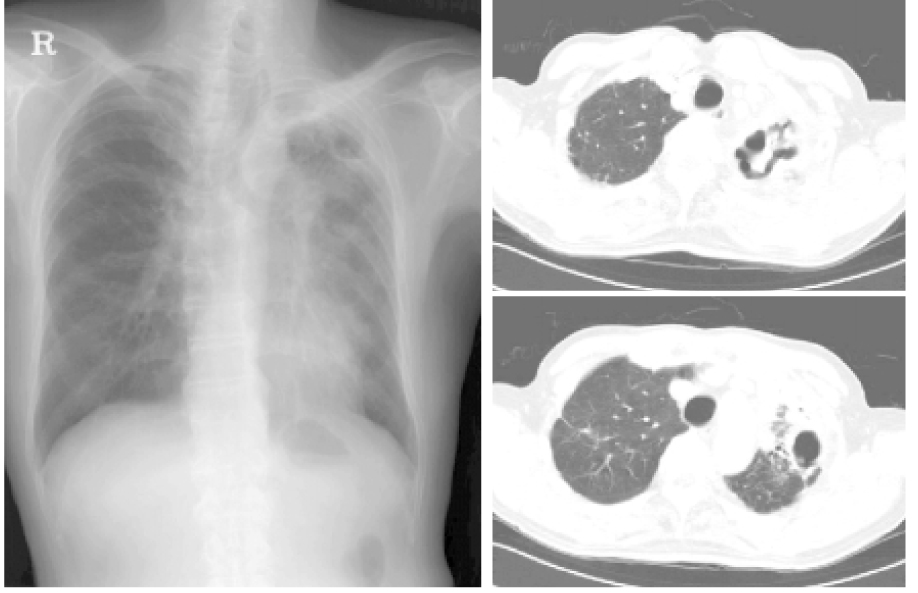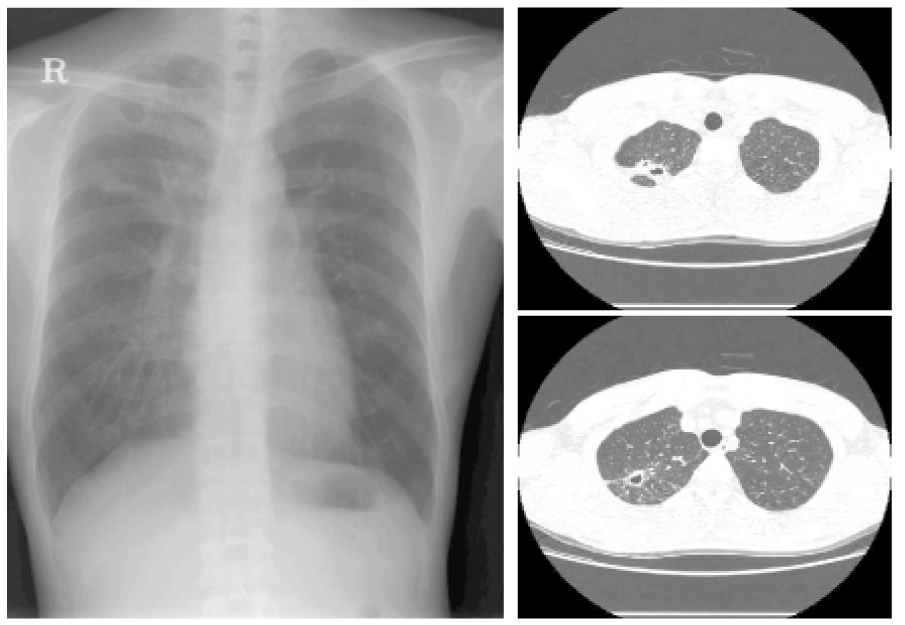J Korean Med Assoc.
2005 Jun;48(6):563-570.
Diagnosis and Treatment of Nontuberculous Mycobacterial Pulmonary Diseases
- Affiliations
-
- 1Division of Pulmonary and Critical Care Medicine, Department of Internal Medicine, Seoul National University College of Medicine and Hospital, Korea. yimjj@snu.ac.kr, hansk@snu.ac.kr
Abstract
- Eight years before the Robert Koch's identification of Mycobacterium tuberculosis, Mycobacterium leprae, which is the firstly identified nontuberculous mycobacteria (NTM), was reported by G.H. Armauer Hansen in 1874. Thereafter a total of 71 species of Mycobacterium have been recognized or proposed. Despite the fact that NTM have been occasionally identified from clinical specimens, it is only recently that they draw a serious attention. In Korea, the frequency of isolation of NTM increased from 448 in 1992 to 1562 in 2002, while the prevalence of active tuberculosis over the same period decreased from 1.8% to 0.5%. The most commonly isolated NTM was M. avium-intracellulare complex (MAC) throughout the period of 1992~2002. M. abscessus was the second common, followed by M. fortuitum, M. gordonae and M. kansasii. In this article, we will overview the NTM-related lung diseases in terms of their diagnosis, clinical characteristics,and treatment.
Keyword
MeSH Terms
Figure
Reference
-
1. Hansen GA. Undersolgelser angaende spedalskhedens arsager. Norsk Magazin for Laegevidenskaben. 1874. 4:1–88.2. Shinnick TM, Good RC. Mycobacterial taxonomy. Eur J Clin Microbiol Infect Dis. 1994. 13:884–901.
Article3. Lee SJ. studies on soil-acid fast bacilli. Tuber Lung Dis. 1966. 23:37–46. (In Korean).4. Kim SJ, Hong YP, Kim SJ, Bae JH, Jin BW, Park JD. A Case of Pulmonary Disease due to Mycobacterium avium-intracellulare complex. Tuber Lung Dis (In Korean). 1981. 28:121–131.5. Timpe A, Runyon EH. The relationship of atypical acid-fast bacteria to human disease: A preliminary report. J Lab Clin Med. 1954. 44:202–209.
Article6. American Thoracic Society. Diagnosis and treatment of disease caused by nontuberculous mycobacteria. Am J Respir Crit Care Med. 1997. 156:S1–S25.7. Erasmus JJ, McAdams HP, Farrel MA, Patz EF Jr. Pulmonary nontuberculous mycobacterial infection: radiologic manifestations. Radiographics. 1999. 19:1487–1505.
Article8. Christensen EE, Dietz GW, Ahn CH, Chapman JS, Murry RC, Hurst GA, et al. Initial roentgenographic manifestations of pulmonary Mycobacterium tuberculosis, M. kansasii, and M. intracellularis infections. Chest. 1981. 80:132–136.
Article9. Reich JM, Johnson RE. Mycobacterium avium complex pulmonary disease presenting as an isolated lingular or middle lobe pattern. The Lady Windermere syndrome. Chest. 1992. 101:1605–1609.
Article10. Prince DS, Peterson DD, Steiner RM, Gottlieb JE, Scott R, Fish JE, et al. Infection with Mycobacterium avium complex in patients without predisposing conditions. N Engl J Med. 1989. 321:863–868.
Article11. Engbaek HC, Vergmann B, Bentzon MW. Lung disease caused by Mycobacterium avium/Mycobacterium intracellulare. An analysis of Danish patients during the period 1962-1976. Eur J Respir Dis. 1981. 62:72–78.12. Horsburgh CR Jr, Mason UG 3rd, Heifets LB, Southwick K, Labrecque J, Iseman MD. Response to therapy of pulmonary Mycobacterium avium-intracellulare infection correlates with results of in vitro susceptibility testing. Am Rev Respir Dis. 1987. 135:418–421.13. Wallace RJ Jr, Brown BA, Griffith DE, Girard WM, Murphy DT, Mazurek GH, et al. Initial clarithromycin monotherapy for Mycobacterium avium-intracellulare complex lung disease. Am J Respir Crit Care Med. 1994. 149:1335–1341.
Article14. Management of opportunist mycobacterial infections: Joint Tuberculosis Committee Guidelines 1999. Subcommittee of the Joint Tuberculosis Committee of the British Thoracic Society. Thorax. 2000. 55:210–218.15. Griffith DE, Girard WM, Wallace RJ Jr. Clinical features of pulmonary disease caused by rapidly growing mycobacteria. An analysis of 154 patients. Am Rev Respir Dis. 1993. 147:1271–1278.
Article16. Han D, Lee KS, Koh WJ, Yi CA, Kim TS, Kwon OJ. Radiographic and CT findings of nontuberculous mycobacterial pulmonary infection caused by Mycobacterium abscessus. AJR Am J Roentgenol. 2003. 181:513–517.
Article17. Bailey RK, Wyles S, Dingley M, Hesse F, Kent GW. The isolation of high catalase Mycobacterium kansasii from tap water. Am Rev Respir Dis. 1970. 101:430–431.18. McSwiggan DA, Collins CH. The isolation of M. kansasii and M. xenopi from water systems. Tubercle. 1974. 55:291–297.
Article19. Engel HW, Berwald LG, Lindeboom BW, Havelaar AH. Mycobacterium kansasii infections in the Netherlands: a brief summary. Rev Infect Dis. 1981. 3:1024.20. Kaustova J, Olsovsky Z, Kubin M, Zatloukal O, Pelikan M, Hradil V. Endemic occurrence of Mycobacterium kansasii in water-supply systems. J Hyg Epidemiol Microbiol Immunol. 1981. 25:24–30.21. Ahn CH, Lowell JR, Onstad GD, Shuford EH, Hurst GA. A demographic study of disease due to Mycobacterium kansasii or M intracellulare-avium in Texas. Chest. 1979. 75:120–125.
Article22. Kubin M, Svandova E, Medek B, Chobot S, Olsovsky Z. Mycobacterium kansasii infection in an endemic area of Czechoslovakia. Tubercle. 1980. 61:207–212.
Article23. Garros Garay J, Garcia Cebrian F, Martin Saco G, Lorza Blasco JJ, Ruiz de Gordejuela E. [Pulmonary disease caused by Mycobacterium kansasii. Analysis of 39 cases]. Arch Bronconeumol. 2001. 37:27–34.24. Koh WJ, Kwon OJ, Suh JY, Cuhung MP, Kim H, Bai GH. A case report of three patients with nontuberculous mycobacterial pulmonary disease caused by Mycobacterum kansasii. Tuberc Respir Dis (In Korean). 2003. 54:459–466.
Article
- Full Text Links
- Actions
-
Cited
- CITED
-
- Close
- Share
- Similar articles
-
- Diagnosis of Pulmonary Tuberculosis and Nontuberculous Mycobacterial Lung Disease in Korea
- Radiologic Diagnosis of Nontuberculous Mycobacterial Pulmonary Disease
- Nontuberculous Mycobacterial Lung Disease
- Treatment of Nontuberculous Mycobacterial Pulmonary Diseases
- Nontuberculous Mycobacterial Tenosynovitis in the Hand: Two Case Reports with the MR Imaging Findings




